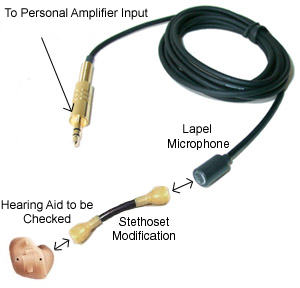Question
I'm a fitter/dispenser with hearing loss. My loss is severe in both ears. As a fitter/dispenser I want to listen to clients' hearing aids to perform Ling tests and to determine the quality of the aids' sound. Generally, dispensers use a 'listening scope.' This scope has a custom earmold for the dispenser that fits on the long tube. This doesn't work for me because when I take out my hearing aids I can't hear much. Amplified stethoscopes are for medical professionals to use when listening to heartbeats, etc., not for listening to patients' hearing aids. There must be other dispensers with hearing loss that have found ways to listen to patients hearing aids. I'd like to know what their solutions are.
Answer
This is a common question among audiology students who have hearing loss, whether hearing aid or cochlear implant user, as they consider the future of their dispensing practice. The root of the problem is your own hearing loss and the difficulty or inability to use a listening scope (or stethoset) to listen to another person's hearing aid. As an example, if you forgo the use of your own hearing aid, the hearing aid to be evaluated may simply not offer enough amplification. Thus, it is imperative to maintain an audible signal.
One difficulty with the listening scopes is the tubing distance from the hearing aid to be checked and your own ear. A quick remedy is to modify the tubing by cutting it shorter. By shortening the tubing distance, the amplified signal travels less far and preserves its output better. However, shortening the tubing distance may make it difficult to perform the Ling test if you cannot place the hearing aid in front of, and closer/away, from your mouth. While this remedy should work well for high output hearing aids, it probably will not work as well for low output hearing aids and will ultimately depend on the severity of your own hearing loss.
When modifying the listening scope tubing distance does not work, you may need to consider a way to use your own hearing aid or find another method of amplifying the other person's hearing aid. There are a number of different potential solutions, but I will describe one here that has been shown to work reasonably well. The basic ingredients are a personal amplifier with small, round or cylindrical-shaped lapel microphone (i.e., assistive listening device) and two stethoset tubes with the rubber bell on the end. The trick is to create a short stethoset tube with the rubber bell on each end. One end of the rubber bell will go over the mouth of the lapel microphone, while the other rubber bell will be used to perform the listening checks on other hearing aids. The microphone is then connected to the input of the personal amplifier (see Figure 1). The output of the personal amplifier, however, will require some thought on your part depending on the type and available features in your own hearing aid, and is not a one-size-fits-all solution. If you have a built-in telecoil, you could place headphones over your hearing aid, or use an ear-level induction silhouette. If you have Bluetooth capabilities, you may be able to connect the personal amplifier to the Bluetooth streamer.
Photo courtesy of Samuel R. Atcherson, Ph.D. and the Association of the Medical Professionals with Hearing Losses (www.amphl.org)
Remember, listening scope checks are subjective, but are useful for fast assessment of feedback issues, mechanical failures, intermittency, etc. The best listening check, however, is none other than a routine electroacoustic analysis on the hearing aid. You should document its performance at full-on and user settings when new and at annual checks. These will be useful references should you perform the electroacoustic analysis again when you suspect a problem with the hearing aid.
Reference:
Association of Medical Professionals with Hearing Losses (Audiology Profession webpage)
www.amphl.org/audiology.php
Samuel R. Atcherson, Ph.D. is assistant professor at the University of Arkansas at Little Rock with joint appointment at the University of Arkansas for Medical Sciences. Dr. Atcherson's research and clinical interests are in the areas of auditory electrophysiology and electrodiagnostics, central auditory processing, and hearing assistive technology. He is former President of the Association of Medical Professionals with Hearing Losses (AMPHL), board member of the Arkansas Hands & Voices chapter, and a proud colleague of a thriving group of hard-of-hearing audiologists.

